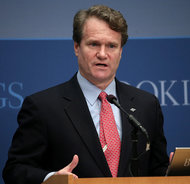The nation’s five biggest mortgage lenders have largely satisfied their financial obligations under last year’s $25 billion settlement over mortgage abuses, helping hundreds of thousands of families keep their homes. But four of the five have yet to meet their commitment to end the maze of frustrations that borrowers must navigate to modify their loans, according to a report on Wednesday by the settlement’s independent monitor.
The most common failure involved a requirement that borrowers be notified in a timely manner of any documents missing from their applications. Banks also failed to meet strict timelines for approving applications. The settlement requires that borrowers be notified of missing documents within five days and given 30 days to supply the missing paperwork and that decisions be rendered at most 30 days after an application is completed.
“I think what you see is there’s still a communication problem,” said Joseph A. Smith Jr., the monitor. “If there’s a unifying feature, it’s that the servicers who failed these things are not yet communicating effectively.”
The mortgage settlement came after the housing crash led to a wave of foreclosures across the country and after widespread improprieties in mortgage lending and in the foreclosure process were uncovered.
The banks report their own performance on 29 loan servicing criteria, and their findings are then tested in a random sampling by outside consultants overseen by the monitor.
Citibank failed three metrics, two of which involve notifying borrowers of missing documents in a timely fashion and one that requires that a letter containing accurate information be sent to a homeowner before foreclosure.
Bank of America failed two metrics, one regarding missing documents and the other regarding the pre-foreclosure letter. Wells Fargo also flunked on the missing documents.
JPMorgan Chase failed to adhere to the prescribed timeline for reviewing loan modification requests and notifying customers of its decision. It also failed to remove home insurance policies, known as forced-place insurance, within two weeks of a homeowner’s submitting proof that he or she had insurance.
The fifth lender, ResCap, formerly the mortgage subsidiary of Ally Financial, whose mortgage servicing is now handled by other companies, was not found to have failed on any of the metrics.
The banks are required to submit a corrective action plan and compensate affected borrowers. Chase, for example, has already refunded insurance premiums charged to 2,000 borrowers. “We quickly fixed the issue,” said Amy Bonitatibus, a spokeswoman for Chase, adding that the timeline problem had been remedied as well.
Wells Fargo said that its internal reviews showed that it had already fixed its problem. Citi said it had fixed one of its issues and was working on the other two.
Dan Frahm, a spokesman for Bank of America, which is responsible for about 60 percent of the total financial obligation under the settlement, said, “While neither area of noncompliance resulted in inaccurate foreclosures or improper loan modification denials, we took immediate action and resolved one area and will soon return to compliance in the other.”
The servicers also submitted to the monitor almost 60,000 complaints received from elected officials on behalf of their constituents. The most common complaints, the monitor’s report said, were related to the bank’s obligation to provide a single point of contact to borrowers seeking modification of their loans. There were also complaints about “dual tracking,” in which the foreclosure process is begun before a borrower’s request for a loan modification is resolved.
Despite the volume of complaints, none of the banks failed the requirement to provide a single point of contact, leading Mr. Smith to conclude that he needed to add more criteria in that area. He said at least three new metrics measuring the efficacy of the single point of contact would be added.

This article has been revised to reflect the following correction:
Correction: June 19, 2013
An earlier version of this article referred imprecisely to a lender that was not found to have failed on any of the metrics. It is ResCap, the mortgage subsidiary of Ally Financial, not Ally Financial itself.
Article source: http://www.nytimes.com/2013/06/20/business/economy/monitor-finds-lenders-failing-terms-of-settlement.html?partner=rss&emc=rss


